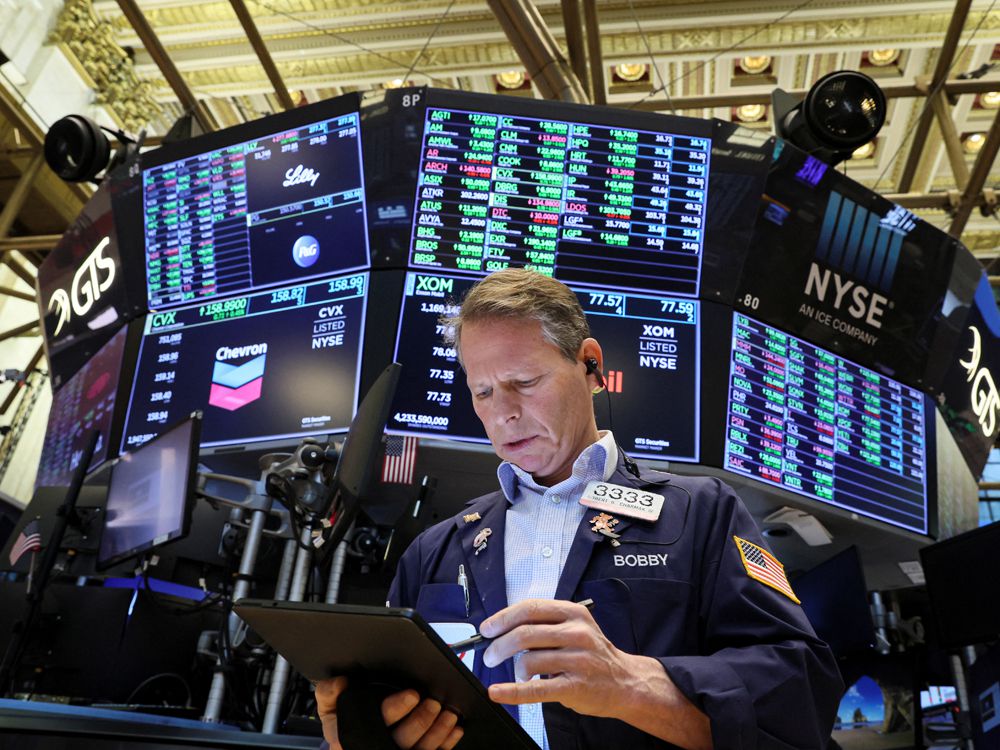Traders are struggling to keep up with massive cash requirements to back up their positions or put on new ones
Author of the article:
Bloomberg News
Archie Hunter and William Mathis
A trader works on the floor of the New York Stock Exchange. Photo by REUTERS/Brendan McDermid files Whipsawing commodity prices and eye-watering margin calls are forcing traders to reduce their activity, driving liquidity out of markets and exacerbating price swings, according to some of the world’s biggest trading houses.
Advertisement 2 This advertisement has not loaded yet, but your article continues below.
“We’re seeing clearly that liquidity in terms of being able to find buyers and sellers in distressed or highly volatile markets is becoming less,” Engelhart Commodities Trading Partners Chairman and Chief Executive Officer Huw Jenkins said at the FT Commodities Global Summit in Lausanne, Switzerland.
Engelhart halved its positions over the past six or seven months, he said. The company is not alone. As commodities swing wildly, traders and industrial players are struggling to keep up with massive cash requirements to back up their positions or put on new ones, which is squeezing participants out of the market.
The drop in liquidity is heightening volatility when prices do move. Benchmark European natural gas, also known as TTF, surged as much as 34 per cent Wednesday as Russian President Vladimir Putin prepared to demand ruble payments for the fuel. That was just the latest example of the wild price swings spurred by Russia’s invasion of Ukraine.
Advertisement 3 This advertisement has not loaded yet, but your article continues below.
It’s not just fossil fuel markets that have become unusually volatile, but also those for other goods that underpin the global economy. Nickel prices have continued to swing wildly on the LME, even after the exchange paused trading for days after the metal soared 250 per cent over two trading sessions in early March. Wheat futures in Chicago jumped by the exchange limit for consecutive sessions earlier this month.
We are in the middle of a storm now
Torbjorn Tornqvist
“We are in the middle of a storm now,” Gunvor Group Chief Executive Officer Torbjorn Tornqvist said. “Many parties got hurt in TTF. And then they realize they just can’t go in with this type of initial margin,” he said, referring to benchmark Dutch gas futures.
Commodity trader balance sheets are also under pressure. Reliant on credit from banks to finance shipments, traders are hitting funding limits when prices rise sharply, curbing their ability to exploit arbitrage opportunities.
Advertisement 4 This advertisement has not loaded yet, but your article continues below.
“It’s simply a general concern across the marketplace that we’re losing participation,” Vitol Group CEO Russell Hardy said. “Capital generally across the market is thinly spread and can’t do as much as it might have been able to do a year ago because the cost of doing businesses has increased.”
The surging volatility may increase as some participants get stopped out of derivatives positions and it becomes more expensive to put on new ones.
Several trading-house executives also said there has been a noticeable shift toward companies placing over-the-counter commodities hedges and bets through banks, rather than on exchanges.
More On This Topic Levels of fear in markets start to return to normal Smart Money Watch: Tech billionaires rally around nuclear as energy crisis looms Canada’s green bond debut sees $12.3 billion in demand This advertisement has not loaded yet, but your article continues below.
Article content While the costs associated with trading commodities are growing, higher prices also mean the traders, especially those with large physical books, need additional credit to finance the cargoes they ship around the world.
That’s prompted a hunt for larger credit lines; Mercuria Energy locked in US$2 billion from banks earlier this month, while Trafigura Group has twice secured new packages in as many weeks.
“We do have to size our activity and our risk appetite with our financing capability. It’s as brutal as that,” said Frederic Barnaud, group chief strategy and commercial officer at Mercuria.
Ultimately, the squeeze is leading to more caution.
“This combination of very elevated volatility combined with significant increase in margin requirements, combined with significant air pockets where liquidity in markets disappears, means you have to take an extremely conservative approach to risk management,” Engelhart’s Jenkins said.
Bloomberg.com
Financial Post Top Stories Sign up to receive the daily top stories from the Financial Post, a division of Postmedia Network Inc.
By clicking on the sign up button you consent to receive the above newsletter from Postmedia Network Inc. You may unsubscribe any time by clicking on the unsubscribe link at the bottom of our emails. Postmedia Network Inc. | 365 Bloor Street East, Toronto, Ontario, M4W 3L4 | 416-383-2300
